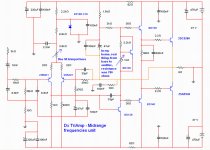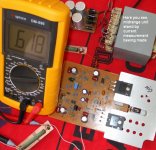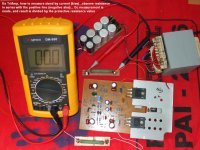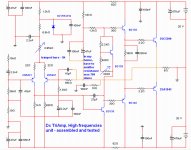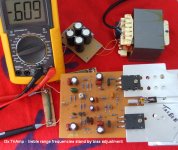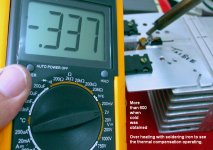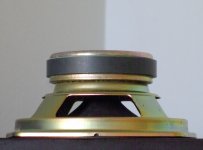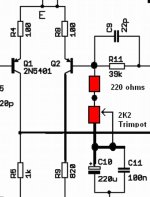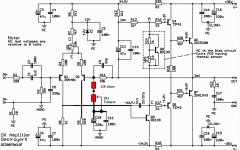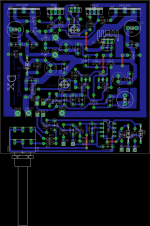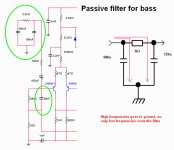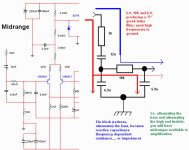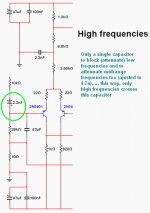Dx TriAmp midrange amplifier was built, adjusted and tested
And worked fine..stable...and wonderfull voices.
regards,
Carlos
And worked fine..stable...and wonderfull voices.
regards,
Carlos
Attachments
Dx TriAmp, High frequency amplifier was built, adjusted and tested
Worked fine!
Dx amplifiers are not simulator sheet of papper...they are real things, built and tested..also pictures are posted to prove you that really exists.
regards,
Carlos
Worked fine!
Dx amplifiers are not simulator sheet of papper...they are real things, built and tested..also pictures are posted to prove you that really exists.
regards,
Carlos
Attachments
The idea...splitting audio band in parts and sending audio to customized
amplifiers resulted UNBEATABLE!....the idea by itself is spectacular...nothing can do better...i am using passive...but i really think active may be even better.... the idea is old alike the time.... in the seventies people were already doing that...but to take that once again was a nice idea i had and even in advance my idea, MJL21193 did something alike.
Also i am thinking into 4 audio bands...the subwoofer, the normal low frequencies called woofer.... some midranges starting a little bit higher in frequency to take some voices high pitch and the super tweeter.
4 amplifiers may be perfect...each one to it's exclusive speaker driver...8 amplifiers into a stereo.... 8 volume controls.... calibrates scale to allow you to know how you are going out from "flat" position..numbers around the 8 volume knobs.
I think the amplifier quality is important...but more than that the power ratio is important and to match sensitivity into all amplifiers....a good amplifier will result worse than an excelent amplifier..but even a good amplifier will beat all others because the idea... the audio band split idea...reducing distortions and sending tones to customized amplifiers to work with them..no passive crossover at the output.
I am listening the TriAmp...and really...unbeatable!...not because Dx Amplifiers...but because the idea..... MJL21193 with his Patchwork is doing even better using passive input.
Here you have a fast test, made rigth now...it is dark because i have not spots here..... quality is not fine because camera cannot capture the high pitch of treble tones..high frequencies, high end does not appear....it is erased by the digital camera...but sound is excelent...tomorrow i will produce better video.
http://www.youtube.com/watch?v=MmEKJihIt2Q
regards,
Carlos
amplifiers resulted UNBEATABLE!....the idea by itself is spectacular...nothing can do better...i am using passive...but i really think active may be even better.... the idea is old alike the time.... in the seventies people were already doing that...but to take that once again was a nice idea i had and even in advance my idea, MJL21193 did something alike.
Also i am thinking into 4 audio bands...the subwoofer, the normal low frequencies called woofer.... some midranges starting a little bit higher in frequency to take some voices high pitch and the super tweeter.
4 amplifiers may be perfect...each one to it's exclusive speaker driver...8 amplifiers into a stereo.... 8 volume controls.... calibrates scale to allow you to know how you are going out from "flat" position..numbers around the 8 volume knobs.
I think the amplifier quality is important...but more than that the power ratio is important and to match sensitivity into all amplifiers....a good amplifier will result worse than an excelent amplifier..but even a good amplifier will beat all others because the idea... the audio band split idea...reducing distortions and sending tones to customized amplifiers to work with them..no passive crossover at the output.
I am listening the TriAmp...and really...unbeatable!...not because Dx Amplifiers...but because the idea..... MJL21193 with his Patchwork is doing even better using passive input.
Here you have a fast test, made rigth now...it is dark because i have not spots here..... quality is not fine because camera cannot capture the high pitch of treble tones..high frequencies, high end does not appear....it is erased by the digital camera...but sound is excelent...tomorrow i will produce better video.
http://www.youtube.com/watch?v=MmEKJihIt2Q
regards,
Carlos
Last edited:
Dark video removed... i have made a new one..and will not be the last one
The amplifier is beeing adjusted.
http://www.youtube.com/my_videos?pi=0&ps=20&sf=added&sa=0&sq=&dm=1
regards,
Carlos
The amplifier is beeing adjusted.
http://www.youtube.com/my_videos?pi=0&ps=20&sf=added&sa=0&sq=&dm=1
regards,
Carlos
Attention folks!.... do not build without ask my assistance, my help!
Because all adjustments are tricky and very hard to make...not easy.
We have to adjust the power into each amplifier to match the ratio/proportion of tones...and this is made entering 1 volts RMS and adjusting the gain resistance to obtain exactly that power....so....maximum volume into the knob means full power (IF) your input is really 1 volt rms.... this means, adjusting all amplifier to 1 volt entering and exitting the power you decided previously, means that all potentiometer positions will be a reference.
Say.... 12 hours to bass knob, 12 hours to midrange knob and 12 hours position to treble knob means you are doing flat.
Also 9 hours to bass knob, 9 hours to midrange knob and 9 hours position to the treble knob means you are also doing flat..same potentiometers, same non linearity in resistance..all three pots the same value, same factory, bougth same day..heheheheh.
Also some adjustment may be needed considering your drivers sensitivity...the philosophy..the idea, is not to use power amplifier full power...so...my 197 watts unit was adjusted to put out 90 watts with 1 volt!.... do you understand....my interest is the ratio between bass, mids and treble.
That stuff is not easy... really it is something to real man!
Are you macho?.... so you are approved to that..if you're chicken do not even try..that stuff is hard!
Guaranteed the stuff is hard!...your hairs will became gray and you will call you mum!
Do not try without talk with fat charlie...god bless you!...you are crazy to do that....hard, hard work...nice, nice, nice..triple nice result!
If i had not started all that stuff i would not do it even to save my mum!.....but i have started and i am a man!...so...let's go!
regards,
Carlos
Because all adjustments are tricky and very hard to make...not easy.
We have to adjust the power into each amplifier to match the ratio/proportion of tones...and this is made entering 1 volts RMS and adjusting the gain resistance to obtain exactly that power....so....maximum volume into the knob means full power (IF) your input is really 1 volt rms.... this means, adjusting all amplifier to 1 volt entering and exitting the power you decided previously, means that all potentiometer positions will be a reference.
Say.... 12 hours to bass knob, 12 hours to midrange knob and 12 hours position to treble knob means you are doing flat.
Also 9 hours to bass knob, 9 hours to midrange knob and 9 hours position to the treble knob means you are also doing flat..same potentiometers, same non linearity in resistance..all three pots the same value, same factory, bougth same day..heheheheh.
Also some adjustment may be needed considering your drivers sensitivity...the philosophy..the idea, is not to use power amplifier full power...so...my 197 watts unit was adjusted to put out 90 watts with 1 volt!.... do you understand....my interest is the ratio between bass, mids and treble.
That stuff is not easy... really it is something to real man!
Are you macho?.... so you are approved to that..if you're chicken do not even try..that stuff is hard!
Guaranteed the stuff is hard!...your hairs will became gray and you will call you mum!
Do not try without talk with fat charlie...god bless you!...you are crazy to do that....hard, hard work...nice, nice, nice..triple nice result!
If i had not started all that stuff i would not do it even to save my mum!.....but i have started and i am a man!...so...let's go!
regards,
Carlos
Attachments
Last edited:
all adjustments are tricky and very hard to make...not easy.
Yes. You should at least use a microphone and some measuring software like ARTA, Speaker Workshop or so.
You seem to have chosen the cross-over frequencies arbitrarily and use only 6dB/oct filters. That might make integration even more difficult.
Those horn drivers you use for mids and highs according to this video will probably need steeper filters and higher crossing frequencies. As a wild guess I would recommend 6-8 kHz between mid-range and tweeter with 12 or 18 dB/oct. The mid-range does not look as if it could do much below 1,5 kHz or so, where it also needs 12 or 18 dB/oct. Although with a bit of equalizing it could make the tweeter obsolete.
I have not appreciate your word arbitrarly, because seems negative
I would like to remember you, dear Paciific Blue, that we all have brain inside the skull...no one is different..we all can take decisions..and this is to behave abritrarly choosen options..we do that all time long..but seems a little negative in my point of view.
I have used the tweeter and midrange technical specifications to choose the frequencies.
Already did this morning the equalization and it is perfect now...with 6 dB or other range of attenuation you have mentioned.... sound is unbeatable!
Folks that decide to build may come to me, and i will send audio mail with detailed instructions about how to adjust..will not post here as there are too many theorists searching for mathematical errors into our thougths..the ones produces nothing but talks a lot searching for other folks mistakes..they keep themselves hidden under the bed..but criticising the ones works hard.
I will stop to publish in this thread..i found no one interested to assemble..so... waste of time..will listen my equipment that is more enjoyable.
Needing uncle charlie...not to theorize things..or enter into a theories discussion (I build things, i am not the one to do those things..i cannot and i dislike...seems non productive to me)..needing to build..with real decision to build something..then call me and i will ready to help.
carlos.eugenio1951@yahoo.com
regards,
Carlos
I would like to remember you, dear Paciific Blue, that we all have brain inside the skull...no one is different..we all can take decisions..and this is to behave abritrarly choosen options..we do that all time long..but seems a little negative in my point of view.
I have used the tweeter and midrange technical specifications to choose the frequencies.
Already did this morning the equalization and it is perfect now...with 6 dB or other range of attenuation you have mentioned.... sound is unbeatable!
Folks that decide to build may come to me, and i will send audio mail with detailed instructions about how to adjust..will not post here as there are too many theorists searching for mathematical errors into our thougths..the ones produces nothing but talks a lot searching for other folks mistakes..they keep themselves hidden under the bed..but criticising the ones works hard.
I will stop to publish in this thread..i found no one interested to assemble..so... waste of time..will listen my equipment that is more enjoyable.
Needing uncle charlie...not to theorize things..or enter into a theories discussion (I build things, i am not the one to do those things..i cannot and i dislike...seems non productive to me)..needing to build..with real decision to build something..then call me and i will ready to help.
carlos.eugenio1951@yahoo.com
regards,
Carlos
Last edited:
I have used the tweeter and midrange technical specifications to choose the frequencies.
I had not intended arbitrary as negative. It was just an impression I got, because you usually explain a lot about the how and why, which you did not do with regards to the crossover. And I remember one post of you, where you wrote that your attempts at speaker design in the past did not leave you satisfied. Your psychology studies will help you understand, how my brain made a connection and created the illusion that I could help you there.
Judging by the video the crossing frequencies seem unfitting to the drivers. Specifications that lead to those frequencies, may be a bit optimistic and driven by the marketing department. While 4 kHz is possible for the tweeter, if stretching it a bit, 300 Hz for that mid-range is physically impossible. The lowest frequency for that size of horn is somewhere in the region of 700-800 Hz and you only get useful sound pressure about 1 octave above that region.
sound is unbeatable!
That's what counts, even if it only holds true until the next project.
I am use low midrange also, sorry if i had not said that... it is a 5 inches LG
driver stollen from an old Philco audio system.
I am having a capacitor (for a while as i have not made the tetra amp) to the horn..it cannot do nothing lower than 3K with reasonable efficiency (real life test listening)...so.... the LG speaker is doing the job reproducing that rich part of the spectrum...capacitor block bellow 3K (attenuate) and this way things goes fine.
This was explained into the Dx BiAmp thread....into TriAmp i have forgot to say..i am using a small box while i prepare a good Midrange enclosure...they use to be good when rounded..something alike old helmets.
I feel sad because i cannot show you all how good it is....my digital camera does not record high frequencies...this turns digital camera video not a very good idea to show quality.... resulted wonderfull.
I do not like the word...it is all rigth...
regards,
Carlos
driver stollen from an old Philco audio system.
I am having a capacitor (for a while as i have not made the tetra amp) to the horn..it cannot do nothing lower than 3K with reasonable efficiency (real life test listening)...so.... the LG speaker is doing the job reproducing that rich part of the spectrum...capacitor block bellow 3K (attenuate) and this way things goes fine.
This was explained into the Dx BiAmp thread....into TriAmp i have forgot to say..i am using a small box while i prepare a good Midrange enclosure...they use to be good when rounded..something alike old helmets.
I feel sad because i cannot show you all how good it is....my digital camera does not record high frequencies...this turns digital camera video not a very good idea to show quality.... resulted wonderfull.
I do not like the word...it is all rigth...
regards,
Carlos
Attachments
To adjust, or equalize your TriAmp, use the resource you have
Mainly your ears, the best wide world instrument for human perception...them some meters, microphones, spectrum analiser, anechoic chamber, decibel meter and so on.
Place your bass potentiometer mid range (12 hours), the same for bass and treble.
Adjust your musical source (CD player, DVD player.... the source you have) to send flat music (attention, flat!..if Ipod, then be sure it is flat!), them tweak each amplifier gain potentiometer to ballance the music to your home/speakers/musical style and sonic taste.... also your ears (mine are old)
Made?.... ready to go!
Images shows the Dx Standard, of course you will adjust your version, the Dx TriAmp bass unit, Dx TriAmp midrange unit and Dx TriAmp treble unit.
regards,
Carlos
Mainly your ears, the best wide world instrument for human perception...them some meters, microphones, spectrum analiser, anechoic chamber, decibel meter and so on.
Place your bass potentiometer mid range (12 hours), the same for bass and treble.
Adjust your musical source (CD player, DVD player.... the source you have) to send flat music (attention, flat!..if Ipod, then be sure it is flat!), them tweak each amplifier gain potentiometer to ballance the music to your home/speakers/musical style and sonic taste.... also your ears (mine are old)
Made?.... ready to go!
Images shows the Dx Standard, of course you will adjust your version, the Dx TriAmp bass unit, Dx TriAmp midrange unit and Dx TriAmp treble unit.
regards,
Carlos
Attachments
Last edited:
Dx Rocks once again...
Whatever uncle Charly does I appreciate because I learn something from it.. It is a nice thinking to create the same amp for different frequencies of the sound spectrum.... He is sharing his experience, knowledge with us.. I wish i i can help him for further development but unfortunately im a noob yet..
You may not need all what he makes but at least one of them. for an example i'm interested of the bass triamp rather than others.. you may be interested another.. sharing your own experience and ideas will help all of us who reads this forum..
I'm sorry that im so broke.. and i work so hard to fix my financial state these days otherwise i dont have $s for foods.. hehehehe.. Therefore I have only very less time to involve with this. But I have something to share with you all..That is nothing but Dx standard with an active filter..(40-180Hz) Im planning to test it soon (once I get a break)...follow the attachments..
Whatever uncle Charly does I appreciate because I learn something from it.. It is a nice thinking to create the same amp for different frequencies of the sound spectrum.... He is sharing his experience, knowledge with us.. I wish i i can help him for further development but unfortunately im a noob yet..
You may not need all what he makes but at least one of them. for an example i'm interested of the bass triamp rather than others.. you may be interested another.. sharing your own experience and ideas will help all of us who reads this forum..
I'm sorry that im so broke.. and i work so hard to fix my financial state these days otherwise i dont have $s for foods.. hehehehe.. Therefore I have only very less time to involve with this. But I have something to share with you all..That is nothing but Dx standard with an active filter..(40-180Hz) Im planning to test it soon (once I get a break)...follow the attachments..
Attachments
Definitely there is a ratio, a proportion into audio sub bands to a pleasant...
reproduction of audio...... and you can see that when you open a speaker enclosure removing speaker drivers and inspecting the power ratio....and usually the ratio is 60 percent to the woofer, 30 percent to the midrange and 10 percent to the tweeter....in watts this means 60 watts, 30 watts and 10 watts, naturally and obviously...and the speaker is rated to 100 watts...and this is correct..because normal music will present that ratio..you will never have music with 90 percent of treble, 5 percent of midranges and 5 percent of bass...this does not exist..it is non natural, non pleasant..intolerable!
I am listening and i have 150W to the woofer (transformer voltage dropped), 50 watts to midranges (transformer voltage, in this case, have not dropped too much)... and 25 watts to the tweeter (almost zero voltage drop into the supply..very low... less than 5 percent).... you see.... if i play 50 watts into the midrange, the needed power to the tweeter to have balance into tones will be 15 watts...and this is possible...no problems.
Even into the woofer i have no problems... 50 watts into the midrange means i will need 100 watts to the woofer and around 15 watts to the tweeter..all fine!
But imagine if i decide to install three power amplifiers rated to 150 watts continuous undistorted!..... now imagine i increase the treble volume to 150 watts undistorted... i will need 450 watts to the midrange to keep the proportion... and this i have not..so..if i try i will have saturation , enormous distortions..not possible..... and now imagine the the bass...having 150 watts into the tweeter, and this is possible..the amplifier can do that...but imagine that we gonna need 900 watts to the bass amplifier...and we have not...so... this is absurd and waste of power.
We have to decide power, and because of that decision, as a consequence, the supply voltage to each power amplifier, accepting the maximum undistorted power we have..and the one will be the woofer amplifier, or subwoofer amplifier..... and that power will be 6/10 of the total power....so, as a consequence, 3/10 must be the midrange power amplifier and 1/10 to the high frequencies power amplifier.... and why this way?
Because your harmonic distortion goes reducing near the maximum power... it is the best condition to listen low distortions.... a few watts bellow the clipping level... almost the threshold is when the harmonic distortion drops.
So... having a 100 watts power amplifier to assemble a TriAmp system..you must produce a 50 watts amplifier to the midranges and 16.5 watts to the tweeter.
Of course you may want a power reserve...but create that power reserve into that proportion or you gonna have clipped signal.
I am playing here and when i reach 25 watts into the tweeter and i try to ballance the tones... to produce harmonious audio, and i go clipping the bass amplifier that cannot reach the needed power (or volume as a resultant of this power) enougth to face 25 watts into high frequencies...i would need a little bit more than 150 watts to scape from the clipping.....
Do you understand that is a waste of power to produce three power amplifiers with the same power ratio?...you will be wasting power, increasing your cost using bigger transformer related the needed one...you gonna be using much more transistors than really needed and you will not operate into the lowest harmonic distortion power.
I hope folks already knows that...and the others that does not know be humble to accept that this is real...and the others that are something alike stubborn that use some time to think about once again.
I am watching this real life...no one told me...i inspected speaker since i was a kid..and was that way...and was that way because it is the correct way!....also i am observing this into my home testings.
regards,
Carlos
reproduction of audio...... and you can see that when you open a speaker enclosure removing speaker drivers and inspecting the power ratio....and usually the ratio is 60 percent to the woofer, 30 percent to the midrange and 10 percent to the tweeter....in watts this means 60 watts, 30 watts and 10 watts, naturally and obviously...and the speaker is rated to 100 watts...and this is correct..because normal music will present that ratio..you will never have music with 90 percent of treble, 5 percent of midranges and 5 percent of bass...this does not exist..it is non natural, non pleasant..intolerable!
I am listening and i have 150W to the woofer (transformer voltage dropped), 50 watts to midranges (transformer voltage, in this case, have not dropped too much)... and 25 watts to the tweeter (almost zero voltage drop into the supply..very low... less than 5 percent).... you see.... if i play 50 watts into the midrange, the needed power to the tweeter to have balance into tones will be 15 watts...and this is possible...no problems.
Even into the woofer i have no problems... 50 watts into the midrange means i will need 100 watts to the woofer and around 15 watts to the tweeter..all fine!
But imagine if i decide to install three power amplifiers rated to 150 watts continuous undistorted!..... now imagine i increase the treble volume to 150 watts undistorted... i will need 450 watts to the midrange to keep the proportion... and this i have not..so..if i try i will have saturation , enormous distortions..not possible..... and now imagine the the bass...having 150 watts into the tweeter, and this is possible..the amplifier can do that...but imagine that we gonna need 900 watts to the bass amplifier...and we have not...so... this is absurd and waste of power.
We have to decide power, and because of that decision, as a consequence, the supply voltage to each power amplifier, accepting the maximum undistorted power we have..and the one will be the woofer amplifier, or subwoofer amplifier..... and that power will be 6/10 of the total power....so, as a consequence, 3/10 must be the midrange power amplifier and 1/10 to the high frequencies power amplifier.... and why this way?
Because your harmonic distortion goes reducing near the maximum power... it is the best condition to listen low distortions.... a few watts bellow the clipping level... almost the threshold is when the harmonic distortion drops.
So... having a 100 watts power amplifier to assemble a TriAmp system..you must produce a 50 watts amplifier to the midranges and 16.5 watts to the tweeter.
Of course you may want a power reserve...but create that power reserve into that proportion or you gonna have clipped signal.
I am playing here and when i reach 25 watts into the tweeter and i try to ballance the tones... to produce harmonious audio, and i go clipping the bass amplifier that cannot reach the needed power (or volume as a resultant of this power) enougth to face 25 watts into high frequencies...i would need a little bit more than 150 watts to scape from the clipping.....
Do you understand that is a waste of power to produce three power amplifiers with the same power ratio?...you will be wasting power, increasing your cost using bigger transformer related the needed one...you gonna be using much more transistors than really needed and you will not operate into the lowest harmonic distortion power.
I hope folks already knows that...and the others that does not know be humble to accept that this is real...and the others that are something alike stubborn that use some time to think about once again.
I am watching this real life...no one told me...i inspected speaker since i was a kid..and was that way...and was that way because it is the correct way!....also i am observing this into my home testings.
regards,
Carlos
Thank you for the nice explanation..
I had the same feeling that why we waste energy and gold for mid and high frequencies but I could never asked the question because I dont understand some technical terms like saturation, clipping etc... but your text are good enough to understand the benefit of making triamp.
I think making filters at the input stage will reduce the cost compared to passive crossovers. correct me if im wrong.. So finally we will have a cheep, high quality, reliable and power saving solution thanks to uncle Carlos..
keep it up !
I had the same feeling that why we waste energy and gold for mid and high frequencies but I could never asked the question because I dont understand some technical terms like saturation, clipping etc... but your text are good enough to understand the benefit of making triamp.
I think making filters at the input stage will reduce the cost compared to passive crossovers. correct me if im wrong.. So finally we will have a cheep, high quality, reliable and power saving solution thanks to uncle Carlos..
keep it up !
Thank you lycanlk....but i am afraid the cost will be lower
Those passive filters uses low voltage capacitors, and they use to be very cheap....also a single resistance or two will not be expensive.
What i do not know, for a while, is the sonic advantage for passive or active...i have to assemble both and compare.
Active can have higher level of attenuation, i do not know if i need that or not..i suppose not.
Passive distorts...but integrated circuit also distorts.
Passive does not need supply, when active will need a 12 volts symetrical supply.
I am not sure...but i think passive is natural.... seems more simple... and simple use to be better...we gonna see in the future.
Also, all of you can try and post your thougths about.
Also, into amplifiers there are some minor modifications..and this cost a little...for the bass amplifiers you will have bigger condensers, but this will be needed for active and passive..so, the cost increase does not counts to passive or to active.
To the midrange amplifier you have reduction of values to capacitors..this reduces cost when we reduce electrolitic condenser capacitive value
Also to the tweeter the cost is reduced.
The complexity into the circuit is very reduced too...easier to build.... operational amplifiers, in special if "golden" or "fashion" models may cost a small fortune!
regards,
Carlos
Those passive filters uses low voltage capacitors, and they use to be very cheap....also a single resistance or two will not be expensive.
What i do not know, for a while, is the sonic advantage for passive or active...i have to assemble both and compare.
Active can have higher level of attenuation, i do not know if i need that or not..i suppose not.
Passive distorts...but integrated circuit also distorts.
Passive does not need supply, when active will need a 12 volts symetrical supply.
I am not sure...but i think passive is natural.... seems more simple... and simple use to be better...we gonna see in the future.
Also, all of you can try and post your thougths about.
Also, into amplifiers there are some minor modifications..and this cost a little...for the bass amplifiers you will have bigger condensers, but this will be needed for active and passive..so, the cost increase does not counts to passive or to active.
To the midrange amplifier you have reduction of values to capacitors..this reduces cost when we reduce electrolitic condenser capacitive value
Also to the tweeter the cost is reduced.
The complexity into the circuit is very reduced too...easier to build.... operational amplifiers, in special if "golden" or "fashion" models may cost a small fortune!
regards,
Carlos
Attachments
There's a say in my country... deeply used to football
- "Never change the team is winning....keep it the way it is!"
It is working Ultima!.... why to put an indecent CCS?
Wanna modify?... put a 12V zener or a 15V zener...but do not put wattermelow into big trees (because watermellow is big) .... when falling down, because mature and ready to be consumed, it can fell down and smash someone's head.
In my country, in the audiophile groups... CCS is understood as
"começou cagand o som"..... this i cannot translate..some words had no translation possible!... maybe "he started shipping sonics"
That thing sounds stérile, lifeless...aaaagh!... this is subjective, personal, my opinion...not a rule or a law..this is what i think...you should think different...no problems.... not all people surrounding us are perfect (hehehehe)
ahahahahahah!
Carlos
- "Never change the team is winning....keep it the way it is!"
It is working Ultima!.... why to put an indecent CCS?
Wanna modify?... put a 12V zener or a 15V zener...but do not put wattermelow into big trees (because watermellow is big) .... when falling down, because mature and ready to be consumed, it can fell down and smash someone's head.
In my country, in the audiophile groups... CCS is understood as
"começou cagand o som"..... this i cannot translate..some words had no translation possible!... maybe "he started shipping sonics"
That thing sounds stérile, lifeless...aaaagh!... this is subjective, personal, my opinion...not a rule or a law..this is what i think...you should think different...no problems.... not all people surrounding us are perfect (hehehehe)
ahahahahahah!
Carlos
Last edited:
I reserve to myself the rigth not to appreciate theories
I do not like theories, to me, theories are are just references
to be checked ... to be tested into real world ... while
i do not listen something perceiving an advantage, i do
not recognize as a reality…just alike hipotesis..something
that comes before…. A “tool”…not a “God”
Also, I am not sorry to say, I do not appreciate theorist..i think most
or them are a bunch of “do nothing”…lazy folks, propagators
of prejudices and beliefs… most of them are addicted to myths
and foolishes and some of them call those things “rule of thumb”
and the worse thing, is that they use to be lazy, or too much
arrogant to test other ideas than the ones they have into their
unshaked skull.
The use of CCS or resistance,or zener, or current sink options
into the differential…well… all those things are very easy and
fast to check…the replacement of a CCS by a single resistance
is fast and easy, and people will be able, doing this way,
to “see”, to listen the real thing, to realise what is really better.
There’s no problem about you Ultima Thule..you are not such
kind of guys, but your question made me suspect you may be addicted
to such kind of group of ideas…. Answering because you’re an old
friend in this forum…and you always behave kindly, also my mum
taugth me to respond when someone ask me something… she said
me to talk with everybody, beeing polite and gentle if possible.
I have spoken of theory more than enough, much more than i would
like to talk ....i have wasted my month stock of small talk into things
i really dislike…I think this was enough and I am stopping here,
sending you a hug and the wish you have already tested those things,
or that you will do that one day.
The guy that have opened this thread is boring, and he may complain
because i am talking off topic things…I will stop.
regards,
Carlos
I do not like theories, to me, theories are are just references
to be checked ... to be tested into real world ... while
i do not listen something perceiving an advantage, i do
not recognize as a reality…just alike hipotesis..something
that comes before…. A “tool”…not a “God”
Also, I am not sorry to say, I do not appreciate theorist..i think most
or them are a bunch of “do nothing”…lazy folks, propagators
of prejudices and beliefs… most of them are addicted to myths
and foolishes and some of them call those things “rule of thumb”
and the worse thing, is that they use to be lazy, or too much
arrogant to test other ideas than the ones they have into their
unshaked skull.
The use of CCS or resistance,or zener, or current sink options
into the differential…well… all those things are very easy and
fast to check…the replacement of a CCS by a single resistance
is fast and easy, and people will be able, doing this way,
to “see”, to listen the real thing, to realise what is really better.
There’s no problem about you Ultima Thule..you are not such
kind of guys, but your question made me suspect you may be addicted
to such kind of group of ideas…. Answering because you’re an old
friend in this forum…and you always behave kindly, also my mum
taugth me to respond when someone ask me something… she said
me to talk with everybody, beeing polite and gentle if possible.
I have spoken of theory more than enough, much more than i would
like to talk ....i have wasted my month stock of small talk into things
i really dislike…I think this was enough and I am stopping here,
sending you a hug and the wish you have already tested those things,
or that you will do that one day.
The guy that have opened this thread is boring, and he may complain
because i am talking off topic things…I will stop.
regards,
Carlos
Last edited:
ok Carlos we can stay with the "indecent" Brasilian CCS! 
I don't know what rails voltages you are going for but I really wondered over the choice of 16 V zener when you had it in your initial design with very high rails voltage.
I can understand you if you want to use a resistor, but like in the first example burning away 74 volts and use 16 volts as the stable voltage for your resistor "CCS" is not very sensible, its like switching place on collector and emitter on a BJT so it is like "up-side-down", in fact it will still work but quite lousy performance and not so reliable, I hope you understand what I mean.
If you want to stay with the resistor design its enough with 2 resistors and 1 capacitor and 1 zener.
Cheers Michael
I don't know what rails voltages you are going for but I really wondered over the choice of 16 V zener when you had it in your initial design with very high rails voltage.
I can understand you if you want to use a resistor, but like in the first example burning away 74 volts and use 16 volts as the stable voltage for your resistor "CCS" is not very sensible, its like switching place on collector and emitter on a BJT so it is like "up-side-down", in fact it will still work but quite lousy performance and not so reliable, I hope you understand what I mean.
If you want to stay with the resistor design its enough with 2 resistors and 1 capacitor and 1 zener.
Cheers Michael
- Status
- This old topic is closed. If you want to reopen this topic, contact a moderator using the "Report Post" button.
- Home
- Amplifiers
- Solid State
- Dx TriAmp bass unit
